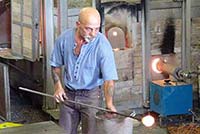Venice's glassmaking island since 1291

Murano has been settled for more than a thousand years, and it became Venice's glassmaking center in the 13th Century.
Today, a small number of artistic and industrial fornaci continue to make glass products that range from glass beads and mosaic tiles to large, elaborate chandeliers and works of art.
Touring glass factories:
The leading glass factories are closed to the public, but a few
tourist-oriented fornaci offer quick glassblowing demonstrations.
As you walk around Murano, look for "glass factory" or "free tour"
signs. After the demonstration, you'll be pointed to the factory's showroom.
- Warning: Glass factories typically shut down for lunch and on weekends, so visit before noon or after 3 p.m. on weekdays.
Hotel concierges and street touts pitch free factory tours (including a boat ride) from Venice. These are legitimate, but if you go, be prepared for an aggressive sales pitch.
In a hurry? The Vecchia Murano Glass Factory offers free glassblowing demonstrations in central Venice, not far from the Piazza San Marco.
Shopping:
Murano has countless shops and factory showrooms.
Most sell a wide range of jewelry, decorative objects, and other souvenirs, but you'll also find art-glass galleries and shops that specialize in items such as mosaic tiles or glass beads.
- Tip: If you want an authentic souvenir, be sure to buy glass that was produced in Murano. (Some unscrupulous vendors and shopowners sell "Murano glass" from China.)
Other things to see on Murano:
The Museo del Vetro (Glass Museum) is outstanding.
Murano has two churches that are open to visitors: the Basilica dei Santi Maria e Donato and the Chiesa di San Pietro Martiri. (Don't miss the Basilica, which has a remarkable marble-and-mosaic floor from the 12th Century.)
The Campo San Stefano, in the middle of the island, has a 19th Century clock tower.
- Tip: Allow time to simply walk around Murano and
perhaps have a drink or a meal at one of the many outdoor restaurants
and cafes.
You can also stay overnight on Murano, which has a number of reasonably-priced hotels and B&Bs.
How to reach Murano:
ACTV, Venice's transit agency, has a number of routes that serve Murano, including:
- 4.1 and 4.2 "circolare" water buses from many locations in Venice;
- Line 3 "Diretto Murano" from Piazzale Roma or the Santa Lucia Railroad Station;
- Line 12 "Lagoon North" water bus from Fondamente Nove.
If you're coming from Marco Polo Airport, take Alilaguna's Blue or Red Line boat to Murano.
